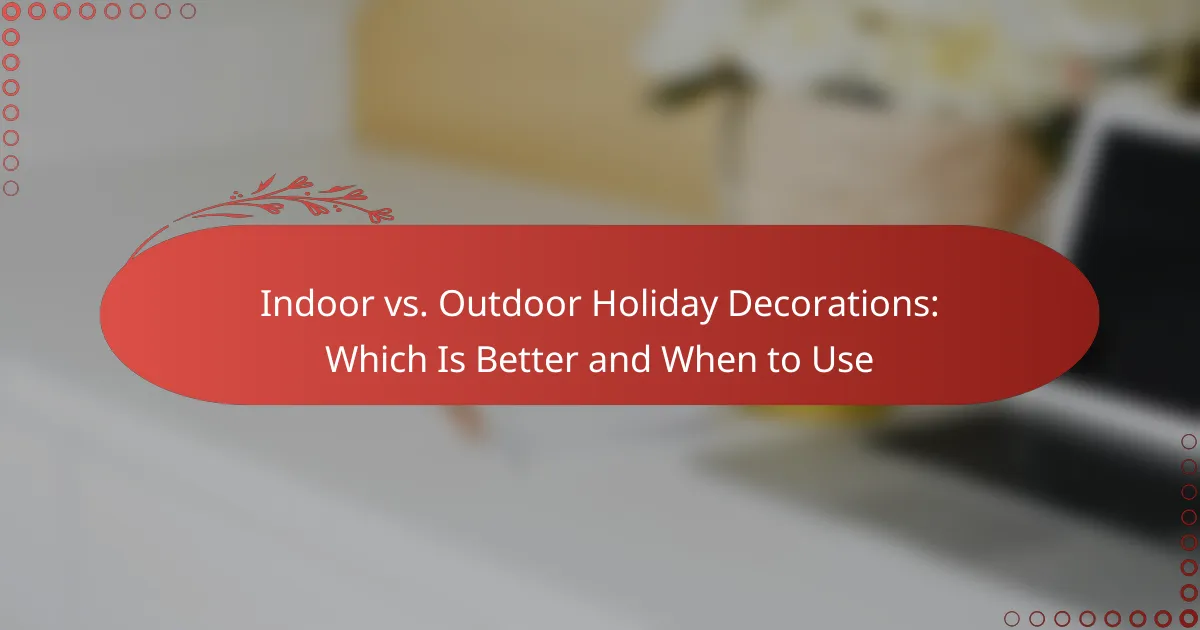When it comes to holiday decorations, choosing between indoor and outdoor options can significantly impact the ambiance of your celebrations. Indoor decorations create a warm and inviting atmosphere, perfect for intimate gatherings, while outdoor decorations enhance your home’s exterior and withstand the elements. Understanding when and how to use each type can elevate your holiday experience and ensure a festive environment both inside and out.

Which holiday decorations are best for indoor use?
Indoor holiday decorations should create a warm and inviting atmosphere while being safe and practical. Common choices include string lights, wreaths, table centerpieces, indoor ornaments, and wall hangings, each serving a unique purpose in enhancing your indoor space.
String lights
String lights are versatile and can be used to add a festive glow to any room. They work well draped over furniture, wrapped around banisters, or hung along walls. When selecting string lights, consider energy-efficient LED options that can save on electricity costs.
Ensure that the lights are rated for indoor use to avoid any safety hazards. Look for features like timers or remote controls for added convenience.
Wreaths
Wreaths are a classic indoor decoration that can be hung on doors or walls to welcome guests. They come in various materials, including fresh greenery, artificial foliage, or even fabric. Choose a wreath that complements your overall decor style for a cohesive look.
Consider seasonal themes; for instance, a pinecone wreath for winter or a floral arrangement for spring. Regularly check for any signs of wear or fading if using artificial wreaths.
Table centerpieces
Table centerpieces can be the focal point of your holiday dining experience. Options range from simple candle arrangements to elaborate floral displays. When choosing a centerpiece, ensure it fits the scale of your table and does not obstruct views during meals.
Incorporate elements like seasonal fruits, pine branches, or decorative ornaments to enhance the festive feel. Avoid overly tall centerpieces that might hinder conversation.
Indoor ornaments
Indoor ornaments add a personal touch to your holiday decor, whether they are hung on a tree or displayed on shelves. Choose ornaments that reflect your style, such as handmade pieces or themed collections. Mixing different textures and colors can create visual interest.
Be mindful of placement; keep fragile ornaments out of reach of pets or small children to prevent accidents. Consider using hooks or stands that securely hold the ornaments in place.
Wall hangings
Wall hangings can transform bare walls into festive displays. Options include fabric banners, framed holiday art, or even DIY projects. Select pieces that resonate with your holiday theme and color palette.
Ensure that wall hangings are securely mounted to avoid falls. Seasonal wall art can be easily swapped out, allowing for a fresh look each year without significant investment.

Which holiday decorations are best for outdoor use?
Outdoor holiday decorations should be durable, weather-resistant, and visually appealing. The best options enhance your home’s exterior while withstanding various outdoor conditions.
Outdoor lights
Outdoor lights are a staple for holiday decorations, providing both ambiance and festive cheer. Look for lights specifically designed for outdoor use, which are typically rated for moisture resistance and temperature fluctuations.
Consider using LED lights as they are energy-efficient and have a longer lifespan compared to traditional incandescent bulbs. String lights, icicle lights, and spotlights can create different effects, so choose based on your desired aesthetic.
Yard inflatables
Yard inflatables are eye-catching decorations that can bring a playful touch to your outdoor space. These inflatable figures come in various sizes and themes, making them suitable for different holidays.
Ensure that the inflatables are secured properly to prevent them from blowing away in the wind. It’s also wise to check the power source and extension cords for outdoor safety ratings to avoid electrical hazards.
Garden stakes
Garden stakes are versatile decorations that can add color and charm to your yard. They often feature festive designs and can be easily placed in flower beds or along pathways.
When selecting garden stakes, opt for materials that can withstand rain and snow, such as metal or treated wood. These decorations can be a great way to highlight specific areas of your garden or to guide guests to your front door.
Outdoor wreaths
Outdoor wreaths are a classic decoration that can enhance your front door or porch. Choose wreaths made from durable materials like faux greenery or weather-resistant natural elements to ensure longevity.
Consider adding lights or ornaments to your wreath for an extra festive touch. Secure them properly to withstand wind and rain, and check for any fading or damage after the season to maintain their appearance for future use.
Pathway markers
Pathway markers can guide guests to your home while adding a festive flair. These decorations can include lighted stakes, lanterns, or themed signs that line your walkway.
When selecting pathway markers, ensure they are visible and stable, especially if you live in an area with snow or rain. Using solar-powered lights can be an eco-friendly option that requires no wiring and provides illumination at night.

When should you use indoor decorations?
Indoor decorations are ideal for creating a warm, inviting atmosphere during specific occasions. They are best utilized during family gatherings, intimate celebrations, and in small spaces where outdoor elements may not be practical or visible.
During family gatherings
Indoor decorations enhance the festive spirit during family gatherings by providing a cozy environment. Consider using string lights, themed centerpieces, and seasonal decor to create a welcoming ambiance. Aim for decorations that encourage interaction, such as a communal dining table adorned with festive elements.
For intimate celebrations
For intimate celebrations, such as anniversaries or small birthday parties, indoor decorations allow for personalization and a close-knit atmosphere. Use candles, soft lighting, and tailored decor that reflects the personalities of those being celebrated. This approach fosters a sense of connection among guests, making the event feel special.
In small spaces
In small spaces, indoor decorations are essential for maximizing the visual impact without overwhelming the area. Choose compact decorations like wall-mounted art or small potted plants that add charm without cluttering. Keep color schemes cohesive to create an illusion of more space, and avoid large items that can make the area feel cramped.

When should you use outdoor decorations?
Outdoor decorations should be used during festive seasons or events when visibility and community engagement are priorities. They enhance curb appeal and create a welcoming atmosphere for neighbors and visitors.
For neighborhood displays
Outdoor decorations are ideal for neighborhood displays, especially during holidays like Halloween, Christmas, or Independence Day. Consider using lights, inflatables, and themed decorations that can be seen from the street to create a festive ambiance.
When planning your display, think about the scale and brightness of your decorations. Bright lights can attract attention, while larger items can serve as focal points. Ensure that your decorations comply with local regulations regarding light usage and noise levels.
During community events
Using outdoor decorations during community events, such as fairs or parades, can significantly enhance the atmosphere. Banners, flags, and temporary installations can help convey the theme of the event and engage attendees.
It’s important to coordinate with event organizers to ensure that decorations align with the overall vision and safety guidelines. Consider using durable materials that can withstand weather conditions, especially if the event lasts several days.
In larger spaces
In larger spaces, such as parks or open areas, outdoor decorations can create immersive experiences. Use larger installations like light tunnels or themed displays that encourage exploration and interaction.
When decorating larger areas, consider the layout and flow of foot traffic. Ensure that decorations are spaced appropriately to avoid overcrowding and allow visitors to enjoy each element. Using a mix of heights and colors can make the space more visually appealing.

How do indoor and outdoor decorations differ?
Indoor and outdoor decorations serve different purposes and are designed with distinct considerations in mind. Indoor decorations focus on aesthetics and comfort, while outdoor decorations prioritize durability and weather resistance.
Material durability
Material durability is crucial when choosing decorations for outdoor use. Outdoor decorations must withstand various weather conditions, including rain, snow, and UV exposure. Common materials for outdoor decorations include weather-resistant plastics, treated wood, and metals that resist rust.
In contrast, indoor decorations can use more delicate materials like glass, fabric, or untreated wood, as they are not exposed to harsh environmental factors. However, these materials may require more care and maintenance to keep them looking their best.
Design complexity
Design complexity often varies significantly between indoor and outdoor decorations. Indoor decorations can feature intricate designs, detailed patterns, and a wide range of colors, as they are typically sheltered from the elements. This allows for creative freedom and personalization in home decor.
Outdoor decorations, however, tend to favor simpler designs that are bold and visible from a distance. They often incorporate larger elements like yard displays or lighting features that can withstand the outdoors while still enhancing the overall aesthetic of the exterior space.










